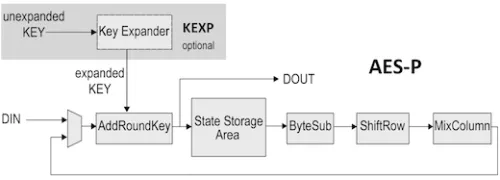The AES-P encryption IP core implements Rijndael encoding and decoding in compliance with the NIST Advanced Encryption Standard. It processes 128-bit blocks, and is programmable for 128-, 192-, and 256-bit key lengths.
Two architectural versions are available to suit system requirements. The Standard version (AES-P-S) is more compact, using a 32-bit datapath and requiring 44/52/60 clock cycles for each data block (128/192/256-bit cipher key, respectively). The Fast version (AES-P-F) achieves higher throughput, using a 128-bit datapath and requiring 11/13/15 clock cycles for each data block. It can be programmed to use any of the following cypher modes: ECB, CBC, OFB, CFB and CTR.
The core works with a pre-expanded key, or with optional key expansion logic.
The AES-P core is a fully synchronous design and has been evaluated in a variety of technologies, and is available optimized for ASICs or FPGAs.
Programmable Mode AES Encrypt/Decrypt Core
Overview
Key Features
- Encrypts and decrypts using the AES Rijndael Block Cipher Algorithm
- Implemented according to the Federal Information Processing Standard (FIPS) Publication 197 from the US National Institute of Standards and Technology (NIST)
- NIST Certified
- Processes 128-bit data in 32-bit blocks
- Employs user-programmable key size of 128, 192 or 256 bits
- Two architectural versions:
- Standard is more compact:
- 32-bit data path size
- Processes each 128-bit data block in 44/52/60 clock cycles for 128/192/256-bit cipher keys, respectively
- Fast yields higher transmission rates:
- 128-bit data path
- Processes each 128-bit block in 11/13/15 clock cycles for 128/192/256-bit cipher keys, respectively
- Supports Electronic Codebook (ECB), Cipher Block Chaining (CBC), Cipher Feedback (CFB), Output Feedback (OFB) and Counter (CTR) modes
- Works with a pre-expended key or can integrate the optional key expansion function
- Simple, fully synchronous, reusable design
- Available as fully functional and synthesizable VHDL or Verilog, or as a netlist for popular programmable devices
- Complete deliverables include test benches, C model and test vector generator
Block Diagram

Applications
- Protected network routers
- Electronic financial transactions
- Secure wireless communications
- Secure video surveillance systems
- Encrypted data storage
Deliverables
- HDL RTL source code (ASICs) or post-synthesis EDIF netlist (FPGAs)
- Sophisticated HDL Testbench (self checking)
- C Model & test vector generator
- Simulation script, vectors & expected results
- Synthesis script
- User documentation
Technical Specifications
Maturity
Production Proven
Availability
Now